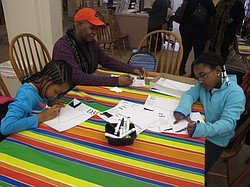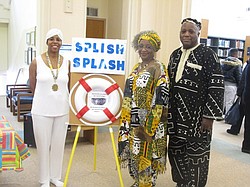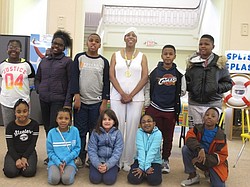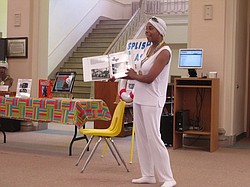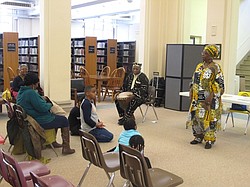Neighbors | Zack Shively.Jennifer Kuczek offered a literary exploration on slavery to finish the Black History events on Feb. 3. She had a number of children's literature to focused on slavery and had a number of activities, such as the coloring activity pictured, for the families at the event.
Neighbors | Zack Shively.The Main library in Youngstown had a series of events for Black History Month on Feb. 3. They had two presentations from speakers and a literary exploration. Pictured are the speakers, from left, Pearlette Wigley, Jocelyn Dabney and Robert Dabney.
Neighbors | Zack Shively.All of the Black History Month aimed to inspire and educate the families that came to the event. Jocelyn Dabney taught through her stories, Pearlette Wigley, pictured, encouraged through Simone Manuel's life and the history of the country and Jennifer Kuczek used literature to open discussions about slavery and African American depictions in media.
Neighbors | Zack Shively.Pearlette Wigley did a presentation on Simone Manuel, the first African American woman to win an individual Olympic Gold Medal. Wigley explained the history behind Manuel's historic win in the 100-meter freestyle.
Neighbors | Zack Shively.Jocelyn Dabney and her husband Robert Dabney told stories with rhythm and rhyme at the Main library. They belong to the Cleveland Association of Black Storytelling.
By ZACK SHIVELY
The Main library began Black History Month with a series of programs about African American history, both distant and recent, on Feb. 3.
Their events included two presentations and a literary exploration for the whole family. The three programs ran back to back to back.
Jocelyn Dabney and her husband Robert Dabney started the events. They are married Youngstown storytellers, who belong to the Cleveland Association of Black Storytellers, a local chapter of the National Association of Black Storytellers. Jocelyn Dabney performed her stories with her husband’s drum beating and singing with her story.
The couple celebrated African heritage through songs and stories. They began with a introduction of who they were and what they did. Robert Dabney had a drum that he beat while Jocelyn explained that the stories she told had rhythm in rhyme, in the tradition of African storytelling.
They began with their rendition of Angela McAllister’s children’s story “Matepo.“ The story followed a monkey on his trip through the jungle gathering fruit. Their performance had singing, clapping, call and response and a good amount of audience interaction.
Then, Robert Dabney began to chant, “Can we make it to the promised land? Yes we can, yes we can.“ His chant worked as an interlude into the next story, which opened on the day of Barack Obama’s inauguration.
Jocelyn Dabney described the scene at the inauguration following a first-person narration. Then, the narrator, revealed to be Harriet Tubman, woke up and told her dream to those around her, invigorating her to continue with the Underground Railroad.
Dabney said she based the story around Tubman’s real-life sleep struggles, where she would fall asleep at any moment and have trouble waking up. Tubman had visions during her sleep, so Dabney thought it would be interesting if she had a vision of the first African American president’s inauguration.
She then took volunteers to help her tell a folktale from Ghana called, “Talk.” Each of the volunteers took the roles of talking objects. She told each of the people what to say and when to say it.
The story covered a surprised farmer who finds a talking yam. He goes to a weaver and then a fisherman, who all find talking objects, such as a bundle of weave and the river. The three run to the king, who does not believe their story, until his royal chair speaks to the four of them.
She ended her presentation with the story of slave named George whose master forced him to eat a whole pumpkin. George began thankful, but soon realized he was being punished once he had to continue to eat after he was full. He escaped later in life and became free in the north, where he had a garden with a variety of fruits and vegetables but no pumpkins.
Joyelyn Dabney, a former librarian, has performed at the library multiple times throughout her 20-year career in storytelling. She said she wants to “educate, entertain and excite“ with her stories. She wants to teach through them, as in the African and European tradition of folktales. She has also published a children’s story, entitled “Nana Bea and Me.“
The second presentation, titled “Splish Splash - Celebrate the Life of Swimmer Simone Manuel,“ focused on Olympic gold medalist Manuel. Pearlette Wigley took the audience on an exploration of historical segregation nationally and locally and led into Manuel’s historic win in the 100-meter freestyle.
She started with an introduction of who Manuel is and what she accomplished. She asked if anyone had watched her get gold, which most people in the room had.
She went into the history behind African American swimmers. She explained the Jim Crow laws put in place to prevent children from swimming in community pools together and left many African Americans without an option to swim.
She told the story of Al Bright, a YSU professor and local artist, who wanted to swim in a community pool after hitting a game winning home run for his baseball team as a children. He was the only African American on the team and his teammate had all gone to the pool to swim. The manager of the pool would not let him in though.
Eventually, after his teammates’ mothers complained, the manager allowed Bright to get in the pool. However, he told all the other children that they had to get out, leaving Bright in the pool by himself. The manager also forced him to sit on a raft and said that he would drain the pool if any part of his body touched the water.
She then explored the life of Manuel. Manuel had always wanted to swim, beginning in her bathtub as a child. As she grew older, she began going to the YMCA to swim and became a competitor. She contrasted Bright’s feeling of isolation to Manuel’s feeling of triumph for becoming the first African American woman to win gold in swimming, inspiring future generations.
Wigley gave the presentation to honor Manuel and encourage children to follow their dreams and ambitions. She felt the story would fit well since the Olympic Games began a week after the presentation. She also said that the children need to know the history of disparity in swimming.
The final event of the Black History Month programming featured librarian Jennifer Kuczek’s literary exploration of children’s literature focused on slavery in American. She included works by authors, such as Virginia Hamilton, and gave parents and children activities based on the material.
She had accurate representations of the oppression the slaves endured, as well as depicting the slaves’ faith and hope. She also showed the families inaccurate representations, such as “A Birthday Cake for George Washington“ by Ramin Ganeshram that showed a false, poorly done representation of slavery.
“Books for children open the door for discussion that might not be so easy,“ Kuczek said. She wanted to open a discussion about what makes a good portrayal and what does not and why. For example, she talked to the children about the controversy that Ganeshram’s book caused since it showed the slaves as happy to work for their masters.
She also had activities for the families. She had a drum, similar to one in a book. She offered them two coloring crafts. She also set up an area to show the size of the average slave cabin, where families had to sleep in a small space.
The events started a series of Black History Month programming throughout the PLYMC. The libraries will have events such as a night dedicated to George Crum, the inventor of the potato chip, at the Poland branch and a Freedom Quilt at the Newport library.
 43
43

